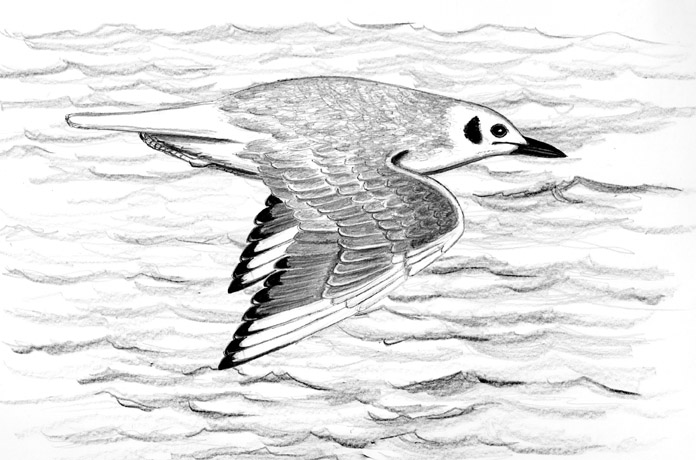
Dear Bird Folks,
For the past few days I’ve been watching a flock of Bonaparte’s Gulls feeding in front of my house overlooking Plymouth Harbor. As I watched these birds I started wondering about their name. Why are they called “Bonaparte’s Gulls”? How did a North American gull end up with a French name? –Terry, Plymouth, MA
It’s a strange one, Terry,
How the Bonaparte’s Gull got its name would make any soap opera writer jealous. He or she would give a week’s pay to have a story this juicy. There’s an illegitimate child involved, a mistress (of course), an abduction, a family feud (not the game show), plus royalty. In addition, the Pope makes a cameo appearance, as well as one of France’s most famous leaders. This story has mini-series written all over it, but I’ll try to explain it the best I can in a few paragraphs. However, before I get to the gossip, I need to explain to the millions of other readers what Bonaparte’s Gulls are. We don’t all live on Plymouth Harbor, you know.
Bonaparte’s Gulls are (big word warning!) the antithesis of “typical” gulls. While many of our larger gulls are lumbering, trash eating, dumpster hogs, Bonaparte’s Gulls are tiny and dainty and wouldn’t be caught dead anywhere near a dumpster. In breeding plumage they have black heads and look like our summer friends the little Laughing Gulls, only Bonaparte’s Gulls are even smaller. Their diet consists of fresh shrimp, small fish and insects. They usually avoid carrion or leftover human food. You aren’t likely to smell a three-week-old bologna sandwich on the breath of a Bonaparte’s Gull. However, you still might not want to sniff their breath, even if you are given the opportunity. Oddly, one of their favorite feeding areas are sewage treatment plants. Now before you get disgusted and think poorly of this bird’s dietary habits, you should know that they are only at the sewer plants to feed on the attracted insects. Bonaparte’s Gulls don’t eat poop. (Dogs could learn something from these birds.)
Most other gulls build their nests on open beaches, dunes or on isolated islands, but not these birds. They build their nests up near the tops of pine trees, just like songbirds do; only the trees they use are located in remote parts of northern Canada and Alaska. (So don’t expect to find gulls competing for nesting space with your cardinals and catbirds next spring.) After breeding, the gulls leave the trees and head south to the U.S. coast and that’s when we see them. By fall they’ve lost their signature black heads and have molted into standard-issue, gull gray and white. You might think that this generic coloring would cause problems with identification, but once again, this is not the average gull. Watching their feeding behavior is all we need to ID Bonaparte’s Gulls. While other gulls crash and splash when feeding, Bonaparte’s Gulls feed by fluttering over the water like a flock of butterflies. Sometimes they don’t even land and will simply pluck food as they go, looking like fairies skipping over the water. (Don’t ask me how I know about fairies skipping over the water. I just do.)
Now we’ve come to the part where we discuss how this non-gull-like gull got its name. The Bonaparte’s Gull is named after the French naturalist Charles Bonaparte. That part is easy. Charles’ background is where the juice comes in. He was born in Paris in 1803. His father was the brother of that crazy Napoleon Bonaparte guy we’ve all heard so much about. His mother was his dad’s mistress. Wanting to do the right thing by Charles, his old man married his mistress, but that didn’t sit well with Napoleon. (Napoleon was fine with invading other countries, but marriage had to be by the book.) In order to avoid the Emperor’s evil eye the family tried to move to America, but was captured along the way by the British Navy. (You just knew the Brits would be involved in this mess somehow.)
The family was held in England until Emperor Napoleon was removed from power. (Are you still with me?) After being released from England, the Bonapartes moved to Rome, where for some reason the Pope made young Charles a prince. (Can Popes do that?) The new Prince Charles then got married…to his first cousin. Soon after the wedding Prince Charles and his new wife/old cousin packed up and moved to (get ready) New Jersey, where they lived on property owned by his uncle/father-in-law. (Once there the “prince” label no longer carried much weight. Royal titles don’t cut it in New Jersey, unless you happen to be the Duke of Earl.)
So how did this illegitimate, cousin-marrying, French guy end up with a gull named after him? Well, somehow, through all the moves, marriages and craziness, Charles became a brilliant ornithologist. At the young age of twenty-one he submitted several papers to the Academy of Natural Sciences in Philadelphia and went on to become a respected contributor to American ornithology. It’s funny how things work out.
The Bonaparte’s Gull was name after Charles Bonaparte, Terry. Charles was a major player in the early days of American ornithology and deserved to have a bird named in his honor, even if he was French. I’m just waiting for the day when they name a bird after me. How cool would that be? I know what you are thinking: “What about the cuckoo?” Knock it off.